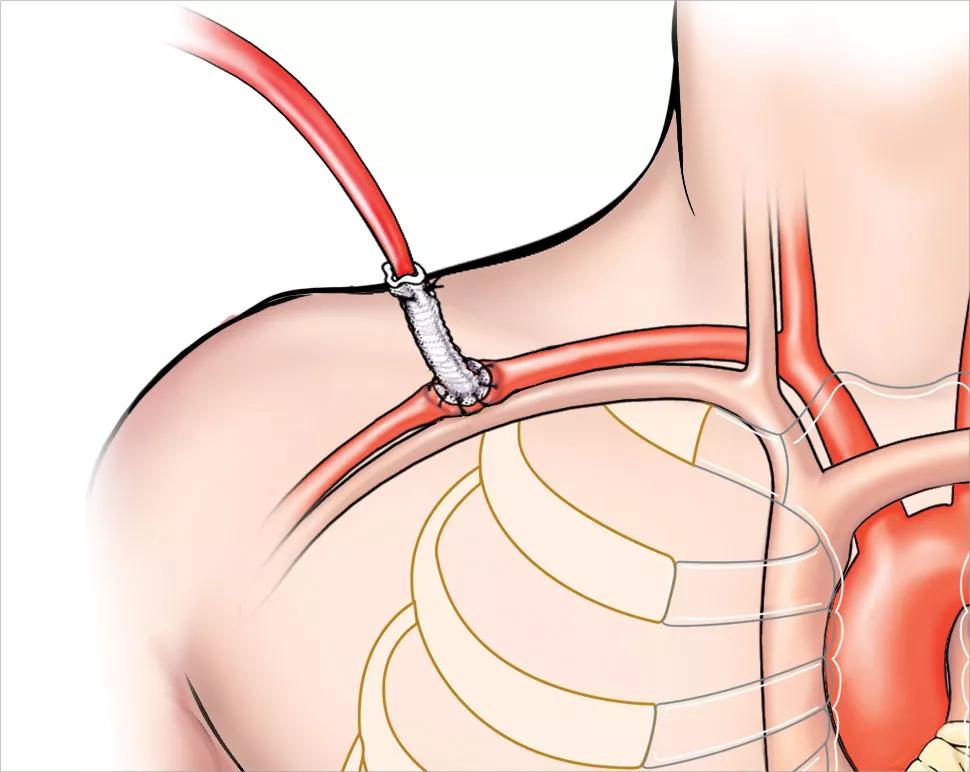Large analysis shows initial axillary strategy is feasible, safe, effective

Systematic use of an initial axillary artery cannulation strategy for emergency repair of acute type A dissection repair is feasible, safe and effective, concludes a retrospective analysis of 775 patients from Cleveland Clinic. The study, published online by the Journal of Thoracic and Cardiovascular Surgery, found that such a strategy can be readily tailored to patients’ individual characteristics and perfusion needs. It further showed that, when used at a high-volume center, this approach results in comparable outcomes regardless of patients’ cannulation site and that outcomes are impacted by patients’ presentation rather than by cannulation site.
Advertisement
Cleveland Clinic is a non-profit academic medical center. Advertising on our site helps support our mission. We do not endorse non-Cleveland Clinic products or services. Policy
Acute aortic dissection is one of the highest-risk emergency operations in cardiovascular surgery, with recent national databases from the U.S. and Germany reporting that one in five patients die after surgery for DeBakey type I or Stanford type A acute dissections.
“Each of the most common cannulation sites for acute type A dissection repair — axillary, femoral and central — offers advantages and drawbacks, and guidelines have been limited by a lack of detail,” says the study’s senior author, cardiothoracic surgeon Lars Svensson, MD, PhD. “Our practice at Cleveland Clinic has evolved into a systematic axillary cannulation approach, with femoral or central cannulation used when axillary access is not ideal or the patient’s presentation argues for another site. We undertook this study to comprehensively review our experience during our shift to this systematic approach and to evaluate patient characteristics and outcomes according to cannulation site.”
He and colleagues reviewed 775 cases of emergency acute type A dissection repair at Cleveland Clinic from January 2000 to January 2017. The site of initial cannulation broke down as follows:
Reasons for choice of a non-axillary cannulation site were as follows:
The cannulation site was shifted intraoperatively in 82 cases (10.6%). This happened most frequently after initial femoral cannulation (53 of 93 cases; 57.0%), followed by initial central (6 of 65 cases; 9.2%) and initial axillary (23 of 617 cases; 3.7%) cannulation.
Advertisement
Notably, as experience mounted, use of initial axillary cannulation increased, approaching 90% by 2016. This came largely at the expense of femoral cannulation, which declined from approximately half of cases in 2000 to less than 10% by 2016.
In-hospital mortality was 8.6% for the overall cohort and was lowest (7.3%) for the axillary cannulation group, but mortality appeared to be driven predominantly by patients’ presenting condition rather than by cannulation site. On multivariable analysis, the following factors at presentation were significantly associated with mortality: hemodynamic instability, stroke, limb ischemia and aortic regurgitation.
In-hospital stroke occurred in 8.3% of patients in the cohort, with multivariable analysis showing it to be significantly associated with central cannulation and with aortic stenosis. “The association of central cannulation with an increased stroke rate may be related to multiple factors, including intraoperative adjunctive techniques, rather than directly causative,” observes Dr. Svensson, Chair of Cleveland Clinic’s Miller Family Heart & Vascular Institute.
“Our finding of comparable outcomes among the different cannulation groups suggests that acute outcomes are related chiefly to the underlying disease and its manifestations at presentation and that cannulation site selection has minimal effect on mortality, at least at experienced centers,” Dr. Svensson continues.
He adds that this study breaks new ground by detailing the decision-making process behind cannulation site choice in the context of a systematic approach. “Most prior studies have examined the use of axillary cannulation in elective settings,” he notes. “In contrast, the decision-making that occurs during treatment of acute type A dissection is a highly dynamic process.”
Advertisement
The advantages of axillary cannulation include maintenance of antegrade true lumen blood flow during and after cooling as well as unilateral antegrade brain perfusion during circulatory arrest. Its chief limitation is that it can be time-consuming, but Dr. Svensson points out that it can be done efficiently when performed routinely.
“We estimate that it adds only 15 to 30 minutes to total operative time,” he says. “In hemodynamically unstable patients, a decision has to be made whether to use central or femoral cannulation. This represents a key strength of this overall approach, which encourages tailoring to patients’ individual needs. However, if time permits, axillary cannulation — in cardiac tamponade patients, for example — allows for going onto ‘sucker bypass’ if the aorta ruptures upon opening the chest.”
He adds that this strategy may have contributed to the favorable outcomes reflected in this study, as its 8.6% in-hospital mortality rate compares well with the 12.7% rate recently reported by the International Registry of Acute Aortic Dissections and a range of 7.7% to 17% in published reports from other groups.
This notion is echoed by the authors of an editorial accompanying Dr. Svensson’s study in the Journal of Thoracic and Cardiovascular Surgery. “The authors are to be congratulated…for their excellent surgical outcomes in a large number of patients,” write the editorialists, two cardiac surgeons at the University of Ulsan in Seoul, South Korea. They note that while initial axillary cannulation was a successful “default set” for acute type A dissection repair, the “flexible application of arterial cannulation techniques needs to also be paid attention to…. A ‘plan B’ should always be readily available.”
Advertisement
Advertisement

Study authors urge reevaluation of the sweetener’s safety designation by food regulators

Surprise findings argue for caution about testosterone use in men at risk for fracture

Findings support emphasis on markers of frailty related to, but not dependent on, age
![GettyImages-1252287413 [Converted]](https://assets.clevelandclinic.org/transform/StoryPanel/350804b2-f1e4-4d97-a277-9629cf45af3e/23-HVI-4120348_redlining_650x450_jpg?w=3840&q=75)
Large database study reveals lingering health consequences of decades-old discrimination

Additional analyses of the two trials presented at 2023 ESC Congress

Prospective SPIRIT-HCM trial demonstrates broad gains over 12-month follow-up

Review of our recent experience shows it’s still a safe option

Machine learning may improve risk prediction and guide therapy